We’re always on the lookout for games that take advantage of the latest PC hardware and although our game performance reviews have included major series such as Battlefield, BioShock, Crysis and Far Cry, we haven’t tested any Metal Gear games despite the franchise’s age and the number of titles it encompasses.
I must embarrassingly admit that I’ve never played a Metal Gear game before, though that’s partly because the series has focused exclusively on console and portable gaming devices for much of its existence, only recently becoming a regular release on PC.
Created by Hideo Kojima and developed and published by Konami, Metal Gear debuted almost three decades ago in 1987 on the MSX2 (a 3.58MHz computer). Since then, MGS has often only been available on PlayStation with Metal Gear Rising: Revengeance being the first modern title to hit PC, though it arrived a year after its launch on the PlayStation 3 and Xbox 360 so it didn’t exactly make waves.
That same year, Metal Gear Solid V: Ground Zeroes arrived but was also delayed on PC for nine months after being released on console. The extra time ensured that the game looked noticeably better on PC thanks to additional lighting, shadows, higher resolution render targets and shadows as well as increased detail over distances — not to mention that it could be played at 60fps and supported resolutions up to 3840×2160 (4K).
The end result was a breathtaking game that we admittedly overlooked. That said, the 60fps lock and the huge delay to PC were probably factors in our decision to skip a performance review of that release (the frame rate lock is also why you don’t see the game being used widely to test the latest GPUs).
Now almost a year after Ground Zeroes hit PC we have a new Metal Gear Solid V title and this time around it shipped simultaneously for PC and console players on 1 September.
Metal Gear Solid V: The Phantom Pain was built using the same Fox Engine as Ground Zeroes so you can expect to see subsurface scattering, physically-based rendering and other impressive technologies.
Testing Methodology
We expect stunning visuals as Konami recommends an Intel Core i7 and GeForce GTX 760 — interestingly, no AMD hardware is mentioned and you can probably thank NVIDIA’s influence for that. Using the latest AMD and NVIDIA drivers, we tested 26 DirectX 11 graphics cards covering most price ranges. Our test rig was outfitted with an Intel Core i7-5960X to remove CPU bottlenecks that could influence high-end GPU scores.
Using FRAPS we recorded 120 seconds of gameplay. The benchmark was recorded while riding a horse through the desert, taking out some enemies along the way.
Metal Gear Solid V: The Phantom Pain was tested at three resolutions: 1920×1080, 2560×1440 and 3840×2160 using the maximum in-game quality settings. Features such as motion blur, volumetric clouds and depth of field were all enabled while the following options were all set to “extra high”: model detail, textures, texture filtering, shadows, lighting, post processing, effects and ambient occlusion.
Test System Specs
- Intel Core i7-5960X (3.00GHz)
- x4 4GB Kingston Predator DDR4-2400 (CAS 12-13-13-24)
- Asrock X99 Extreme6 (Intel X99)
- Silverstone Strider Series (700w)
- Crucial MX200 1TB (SATA 6Gb/s)
- HIS Radeon R9 390X (8192MB)
- HIS Radeon R9 390 (8192MB)
- HIS Radeon R9 380 (4096MB)
- HIS Radeon R7 370 (2048MB)
- HIS Radeon R9 290X (4096MB)
- HIS Radeon R9 290 (4096MB)
- HIS Radeon R9 285 (2048MB)
- HIS Radeon R9 280X (3072MB)
- HIS Radeon R9 270X (2048MB)
- HIS Radeon HD 7970 GHz (3072MB)
- HIS Radeon HD 7970 (3072MB)
- HIS Radeon HD 7950 Boost (3072MB)
- HIS Radeon HD 7950 (3072MB)
- HIS Radeon HD 7870 (2048MB)
- Nvidia GeForce GTX Titan X (12288MB)
- Gainward GeForce GTX 980 (6144MB)
- Gainward GeForce GTX 980 (4096MB)
- Gainward GeForce GTX 970 (4096MB)
- Gainward GeForce GTX 960 (2048MB)
- Palit GeForce GTX 950 (2048MB)
- Gainward GeForce GTX 780 Ti (3072MB)
- Gainward GeForce GTX 780 (3072MB)
- Gainward GeForce GTX 770 (2048MB)
- Palit GeForce GTX 760 (2048MB)
- Gainward GeForce GTX 680 (2048MB)
- Gainward GeForce GTX 660 Ti (2048MB)
- Microsoft Windows 10 Pro 64-bit
- NVIDIA GeForce 355.82 WHQL
- AMD Catalyst 15.8 Beta
Benchmarks: 1080p
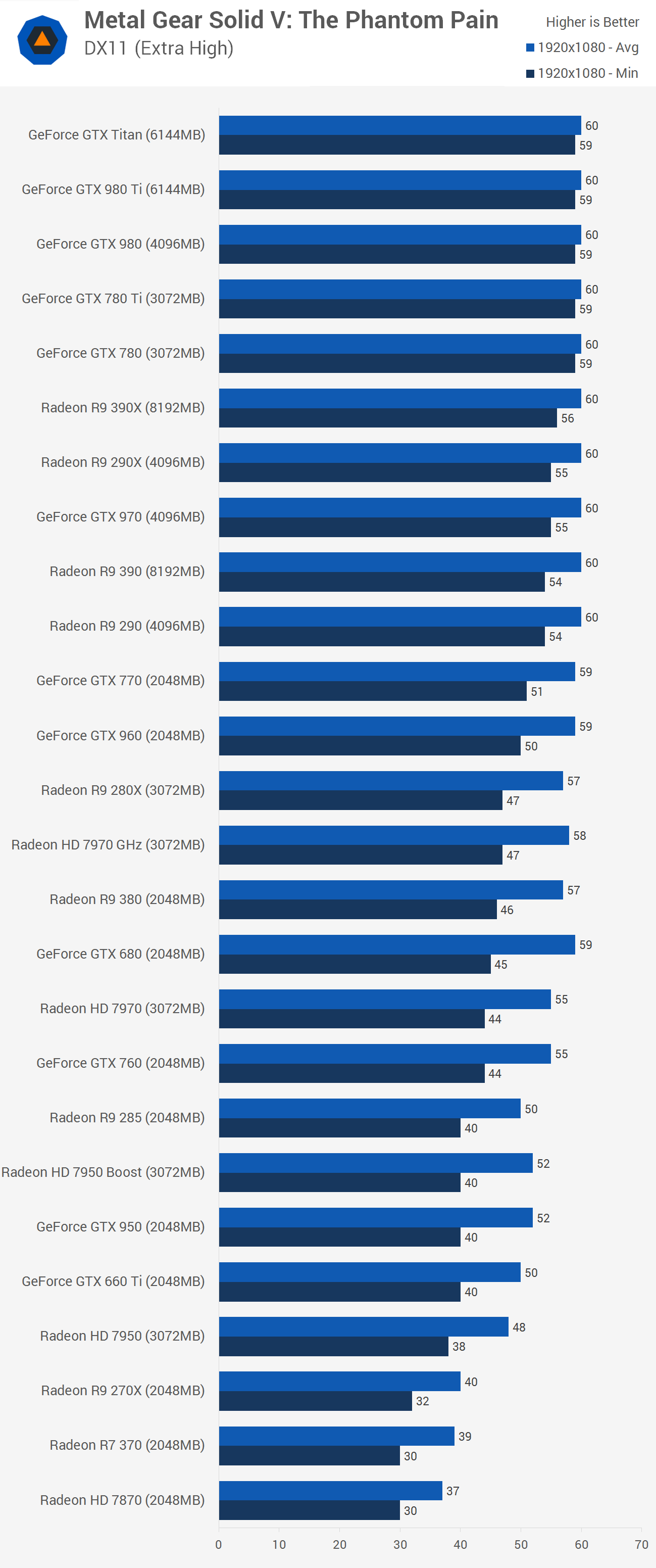
Those looking to play The Phantom Pain at 1080p will get away with relatively low-end/dated hardware. The nearly four year old HD 7950 averaged 48fps with a minimum of 38fps (very playable) while the new GTX 950 provided a strong average of 52fps with a minimum of 40fps.
NVIDIA has a clear advantage in this title at the moment and that can be seen when making numerous comparisons. The GTX 950 for example was 33 per cent faster than the R7 370 when comparing minimum frame rates and the GTX 970 was just a single frame slower than the R9 390X.
Older GPUs that NVIDIA and AMD seem to have stopped supporting or at least optimising we should say still managed to provide competitive performance. For example, the GTX 680 was on par with the 7970 GHz Edition.
Benchmarks: 1440p
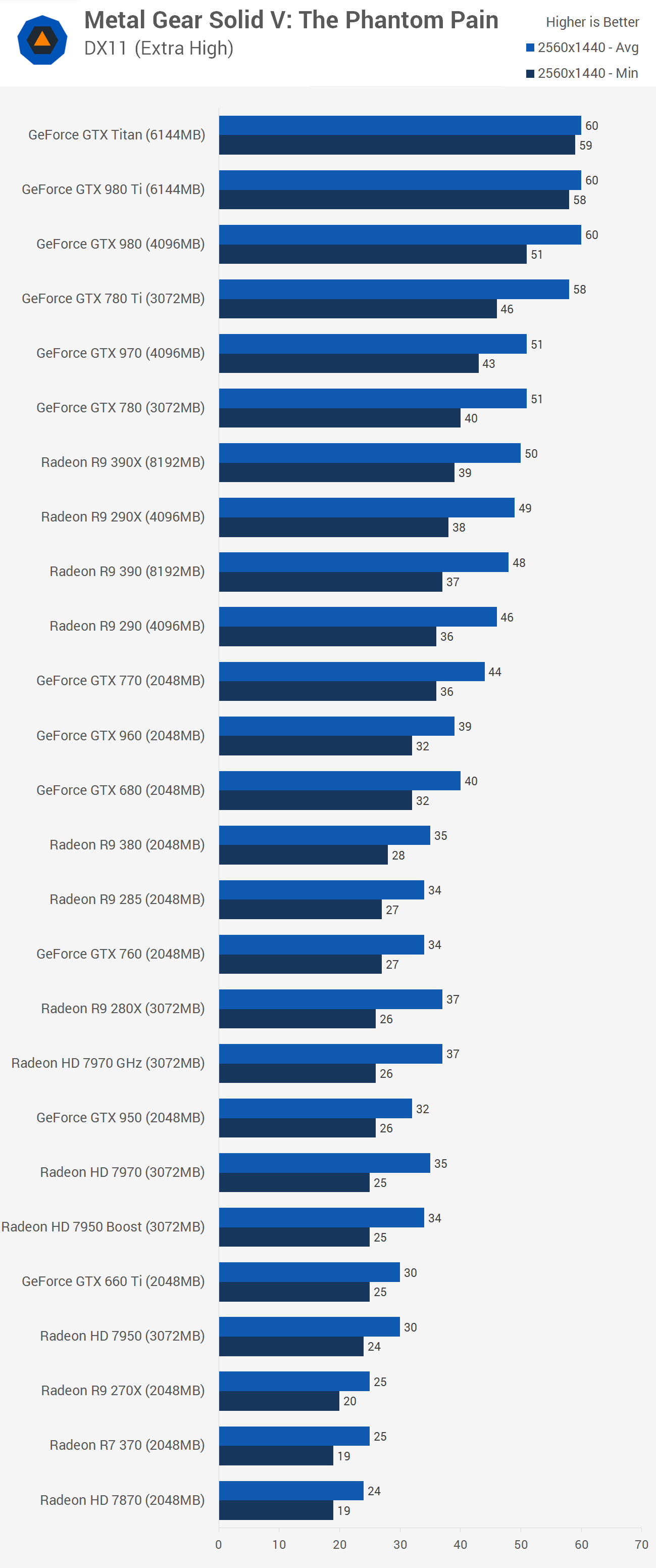
Running at 1440p scrubbed out the lower-end cards. The HD 7950 was good for just 30fps on average with a 24fps minimum. To maintain at least 30fps or more at all times you’ll need at least a GTX 680 or GTX 960 from NVIDIA or R9 290 from AMD, though the R9 380 did come close with a 28fps minimum.
NVIDIA’s big guns were still able to reach the 60fps limit and while the GTX 980 was good for 60fps on average, it did drop down to 51fps at times.
The older GTX 780 Ti and GTX 780 performed well here and we’ve become used to seeing the GTX 780 rubbing shoulders with the GTX 960 lately rather than the GTX 970. The R9 390X was slightly slower than the GTX 970 and GTX 780.
Sorry for the absence of the Fury X and Fury graphics cards but AMD can’t send us samples at this point and we can’t even buy them.
Read More:
|
Republished with permission from:

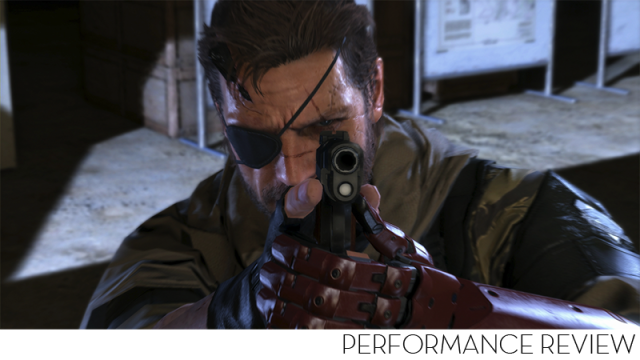
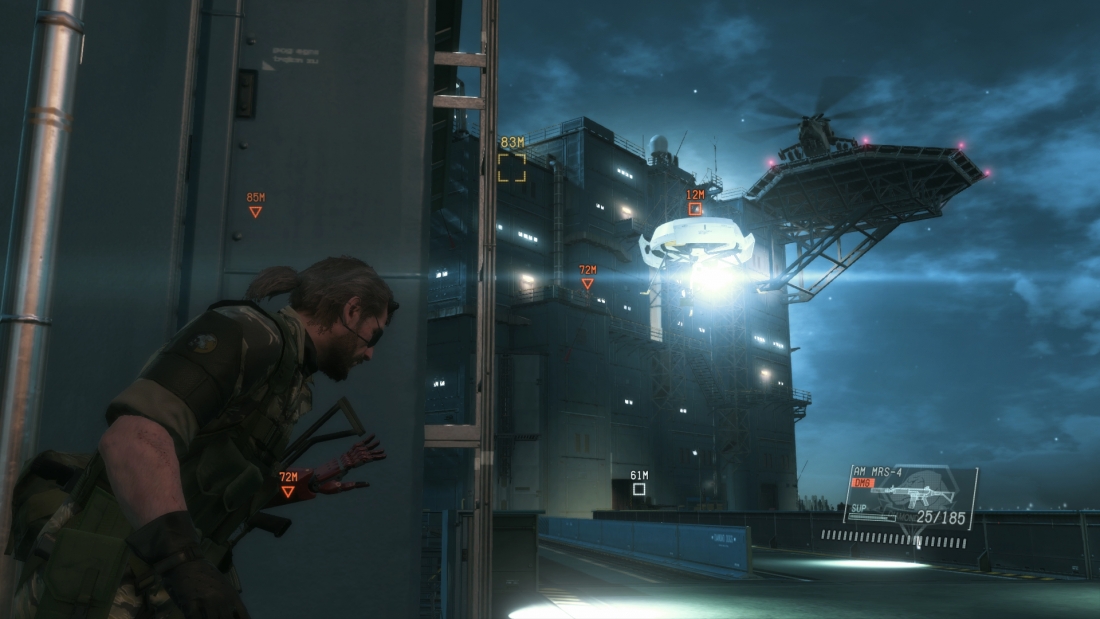
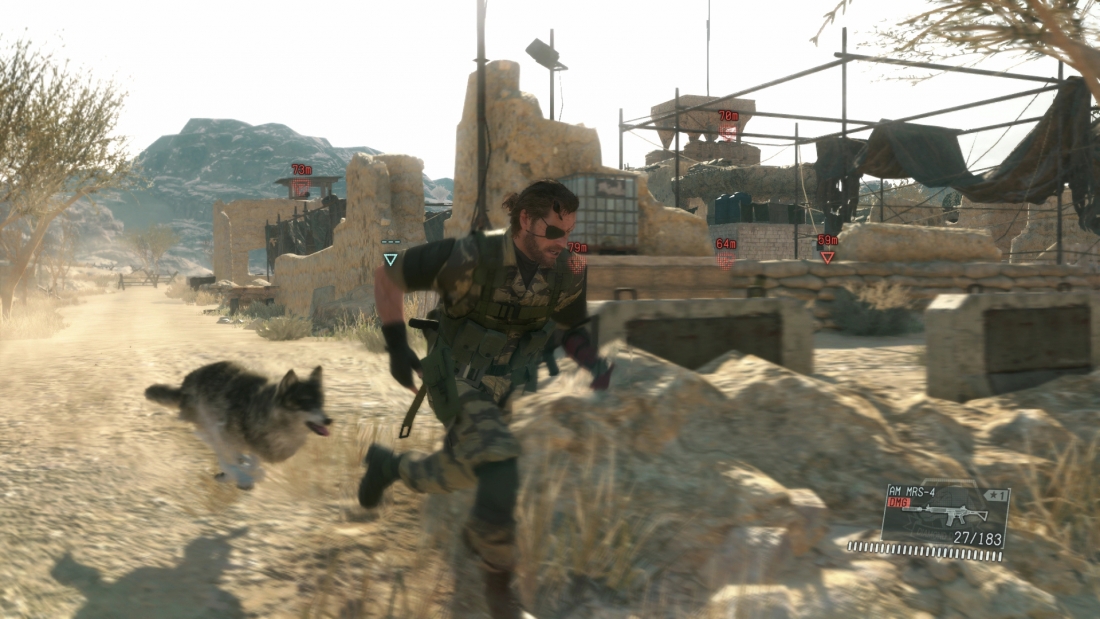
Comments
26 responses to “The Phantom Pain PC Benchmarks Are Relatively Painless”
I get a solid 60fps at 1440p with a GTX 980, 16gb RAM and an i7 4790k.
The game looks absolutely amazing and is probably one of the most well optimised games i have played.
I do like it when care is taken with a game to make sure it runs well.
Yea I love when companies bring games over that lived on console, I also love when they put time into smooth releases… The only thing I can fault it on is lack of individual settings i.e. post processing setting covers many effects including AA which would be nice to be able to control and its locked at 60fps.
but the fact the two problems are rather nit picky its still a solid 9.5 out of 10 for PC release. Any easily a must by for anyone interested in the game… someone should send a copy to Warner Bros to show them how releases should look.
Shots fired!
Awesome! Just got a new rig with a high end AMD chip, 970 gainward 4gb card and 16gb ram (only ddr3 but was on a budget) so I’m looking for something to truly test it. Looks like this is it 😀
I wouldn’t worry about DDR3, DDR4 benefits are minuscule at best even when comparing performance outside of gaming, for gaming however there is little difference between 1033 mhz and 3000 mhz when comparing DDR3. The two main things for ram is frequency and latency. Frequency is 1033mhz or 3000mhz and is basically the bandwidth of the memory, but with higher bandwith or frequency, latency is often sacrificed. With latency (access speed) you tend to sacrifice frequency. At the end of the day 1033, or 1600mhz ddr3 is plenty for a just about any rig and the real question is quantity i.e. 8gb, 16gb etc.
Nice rig btw.
Thanks 🙂 Also went and bought 2 monitors to replace the tv I was using (tv was starting to hurt my eyes, I’m 37 and have had to start using my reading glasses lol, old man me). But all up cost me in the area of around 1100? I Already had the power pack and the case from my previous rig (power pack was brand new, a 1000watt one). So Gutted it and got new parts. I know people go on about Intel etc, but working with a budget meant going AMD (And tbh, I’m happy with AMD stuff at this point, it’s done well for me).
I am an Intel fan personally, but when people compare AMD to Intel they tend to not talk in relative terms. If you had a 144hz screen and wanted max fps from the newest triple A games then Intel all the way. But when you only need 60 frames for your 60hz monitor AMD becomes a compelling buy. When taking budgets I personally would rather an AMD with a 970 then a Intel with a 960 any day of the week, its the smart buy.
Indeed, I’d have bought an intel rig if I had the money but at the moment, on a very limited budget (student budget) but once I’m working again, we’ll splash out for my son and I and buy beast rigs for each of us lol.
This isn’t the game to test it on Weresmurf. I’m running it on max everything and it doesn’t break a sweat. Try something like Ark if you want to see your computer feel the Pressure.
Have Ark and have been using it on that, getting around 50fps regularly. Ark won’t truly be worth testing it on until they release the proper Win10 update for it unfortunately.
Unigine Benchmark is fun to taking your GPU for a spin. And is great for testing overclock stability.
Or just try 3D Mark and pick the higher 4k Ultra benchmarks 😀
Or just try 3D Mark and pick the higher 4k Ultra benchmarks 😀
double post oops
I get a rock solid 60 (dip to 59 but I think that is not the GPU) at 4K with everything maxed and HBAO through the nVidia driver. Downsampled to 1080p though. This is on two 980ti yes but the fact this game does that no matter what happens boggles my mind. Brilliant PC engine.
All my friends with mid end hardware are smashing the detail and keeping 60fps. This is PC done right. It is a shame the engine will now go to massive waste, FucKonami.
Love it, new hashtag #FucKonami
Yeah it is a Jim Stirling thing and it has become a hash tag. It is great and well deserved from what Konami has done to SH, MGS, Castlevania etc etc.
Thank god for Jim!
Jim F***ing Stirling Son!
I start watching 1 video of his….
10 or so videos later….
Yeah and you are a better person for it. Seems reasonable. I usually only watch the Jimquisition stuff though.
I would assume a GTX 650 Ti Boost is also good since it ran Ground Zeroes pretty well as well… well.
“Since then, MGS has often only been available on PlayStation with Metal Gear Rising: Revengeance being the first modern title to hit PC”
If modern means the SOLID series then you missed the PC release of Metal Gear Solid 2 (Substance)
There was a PC release of the original MGS as well.
Yes and the amount of people who have forgotten blows my mind. I wish I bought a copy in the day. It would be worth a lot and now that I think about it, #FucKonami for not putting it on Steam already.